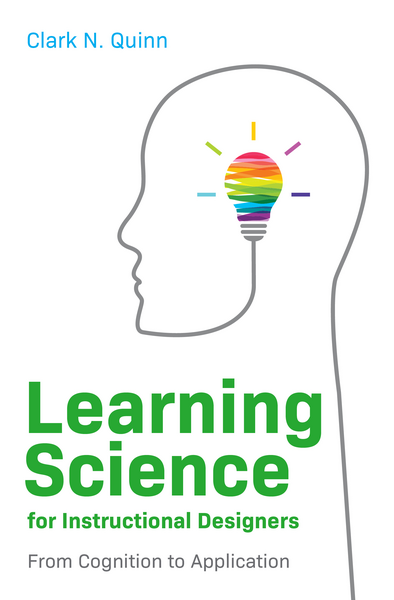ATD Blog
Learning Science for Instructional Designers: Q&A With Clark N. Quinn
Tue Apr 13 2021

Learning science is a professional imperative for instructional designers. In fact, instructional design is applied learning science. Learning Science for Instructional Designers: From Cognition to Application by learning technology expert Clark N. Quinn, a co-founder of the Serious eLearning Manifesto, provides critical information on the intersection of learning science and cognition, an understanding that instructional designers often lack but need to ensure that they are creating the most effective learning experiences for their learners.
Why did you write this book?
When I think about it, this book’s origins go way back. When I was doing my undergraduate studies, I saw the connection between computers and learning and designed my own major on this topic. This has been the focus of my career ever since. I am proud of my field, which has evolved dramatically over the years. Yet, when I look at what has been and is being done, I see what needs to happen and what is not as good as it could, and should, be. Several of us dedicated to learning science took a stab at trying to remedy this deficiency with the Serious eLearning Manifesto—a pledge to elevate e-learning by adhering to proven guidelines—that we initiated in 2014. When ATD suggested this book project to me, I saw it as another opportunity to close the gap.
There are a lot of instructional designers and accidental instructional designers who’ve been put in the role without a strong background in learning. They are trained to follow the house process and given tools, but they don’t really know the reasons behind why they do it the way they’re asked. There’s a dearth of knowledge about the underlying science, and there are strong reasons to know about how we learn. This book gives readers the background they need to do credible, scrutable work.
Why is learning science important for instructional designers?
Learning science is an integration of a wide variety of research on how we learn, integrating cognitive science, instructional design, education psychology, and more. My first job after college was designing and programming educational computer games. I recognized that we didn’t know enough about how to design these games and went back to get a PhD in what was, effectively, applied cognitive science. With a restless curiosity, I looked across these fields more, looking to create a useful synthesis. I was excited when the field was formed. With a sound basis of understanding, we can create the best solutions possible. I’ve been able to design engaging and effective learning across technologies (games, mobile, web, and more) because I know the science. And that’s what I want others to be able to do! It also gives us a basis to know what corners to cut, and when, to work under real world constraints.
What is the connection between learning and how our brain works?
What I’ve learned is that learning is not separate from how our brain works; these two things are intimately related, and the relationship is complicated. Arguably, the mind is the most complex thing in the known universe—when you think about it, cognitive science makes rocket science look simple! Yet, there is a basic model at core that’s comprehensible. Starting from the fundamentals of the brain to what that means for learning, I introduce an overview of our fundamental cognitive processing, from sensory stimuli through to long-term learning. I explore our cognitive architecture using a “stores and processes” model, and I look to the properties that emerge from that architecture.
The title says, “for instructional designers”. Is the relevance restricted to them?
I’ve thought that the most valuable degree you could get would be a combination of three things: cognitive science, technology, and design. With those three things, you can create solutions for most anyone. (Okay, maybe you add something about business in there.) And, really, cognition also underpins design. This book starts with the basics of cognitive science before going into the learning. So, first, that core of cognitive science is really useful for most anyone because almost anything you do involves humans, and understanding how we think gives you an advantage. Second, everyone really needs to keep learning. Understanding your own learning is as important for you as understanding others’ learning is for instructional designers. Third, ‘instructional designers’ include teachers, faculty members, coaches and mentors, managers, and even parents! While the title is limiting in that regard, I hope others will find the book useful as well.
How do our brains’ neural activity impact our learning?
While our brains are neural, we don’t design learning at this level. We typically work by activating concepts in contexts and explicitly tying labeled things in the world together. This isn’t the neural level; it’s the cognitive level. It’s like how your car runs gas or electricity, but you don’t control those directly; you instead control the accelerator pedal and the brake. In the end, you’ll continue to see a lot of “neural” branding in our field. And, sad to say, it’s largely hype. It’s trendy to ride the flash that accompanies the label of neural, but it’s misleading. Yes, you’re strengthening neural-pattern connections, but you’re doing so at the cognitive level.
In this book, I look at particular phenomena that arise from our cognitive architecture that relate to learning. This includes things like the importance of context, the role of models, why we need spaced learning, and more. This is designed to be just enough to give you a solid foundation to design learning for the necessary outcomes.
What influences should and can learning design address?
While there is a cognitive architecture that underpins learning design, instructors are not thinking about the underlying architecture but rather are focusing on the thinking and learning that runs on the architecture. We’ve got to account for how to present information, what to present, how much to present, and more. We need to be careful about what we have learners do, when, and know what helps and hinders.
Do you go beyond the traditional learning in any important ways?
The traditional model of the formal cognitive reasoner has been upended. This was happening as I was a grad student, and I got to watch a major shift in our scientific understanding. Thus, the presentation brings in several important extensions to learning. In one chapter, we portray the “post-cognitive” state of our understanding. Our cognition, it turns out, is an emergent property of the interaction between our experience and our current context.
Further, our understanding is not just “in the head” but is distributed across our representations and other people! We use tools like spreadsheets and diagrams to externalize thinking too complex to keep in mind, and we complement our skills with the abilities of others to accomplish goals beyond our own ability. This is true for learning as well. Thus, we’re making that clear and showing the implications for learning.
We also cover the emotional side of learning, recognizing that motivation, anxiety, and confidence can all have an effect on learning. You don’t learn well if you’re bored or overly anxious, and if you haven’t developed confidence, you might not apply the learning even if you recognize it’s appropriate. One other important aspect we cover is meta-learning (or learning to learn). Here we’re talking about ways in which to help learners become better learners in addition to what they’re learning.
Are there any guides for how learning science gets applied?
There are two major factors that help promote using this information in practical ways. First, after each presentation section, there’s a “learning” that indicates what the takeaway lesson should be. These are also accumulated at the end of the book. Second, the penultimate chapter takes a different cut through the content, going through each aspect of learning and indicating the important elements. Cognitively, we know taking a different path through the content reactivates, and seeing it applied supports acquisition. We detail the implications for introductions, concepts, examples, practice, and closing. For example, elaborating how practice should be spaced and appropriately challenging. The goal is to not just outline the learning science but to support it in being put into practice!
Is this a theoretical or practical treatment?
This book is designed to be the best of both worlds. It covers theory but provides specific, practical guidance. The goal is to synthesize the most important elements of cognition and learning, and present it in a comprehensible and applicable format. While it’s based upon sound cognitive and learning science research, it’s been reduced to a coherent core then translated into plain language. The intent is to be a tool to help spread useful understanding, not to provide the definitive scientific documentation.
About the Author
Clark N. Quinn is a recognized expert and scholar in the field of learning technology. He assists Fortune 500, education, government, and not-for-profit organizations in integrating learning science and engagement into their design processes. He has a track record of innovation and has consistently led development of advanced uses of technology, including mobile, performance support, and intelligently adaptive learning systems, as well as award-winning online content, educational computer games, and websites. Previously, Clark headed research and development efforts for Knowledge Universe Interactive Studio and held management positions at Open Net and Access CMC, two Australian initiatives in internet-based multimedia and education.
Clark keynotes nationally and internationally and is the author of numerous publications, including Millennials, Goldfish & Other Training Misconceptions: Debunking Learning Myths and Superstitions (ATD Press, 2018) as well as four previous books. In 2012 he was awarded the eLearning Guild’s first Guild Master designation. He blogs at Learnlets.com, tweets as @quinnovator, and serves as executive director of Quinnovation.
About ATD and ATD Press
The Association for Talent Development (ATD) is the world’s largest association dedicated to those who develop talent in organizations. ATD’s members come from more than 120 countries and work in public and private organizations in every industry sector. ATD Press publications are written by industry thought leaders and offer anyone who works with adult learners the best practices, academic theory, and guidance necessary to move the profession forward. For more information, visit td.org/books.

Learning Science for Instructional Designers
ISBN: 9781952157455| 144 Pages | Paperback
To order books from ATD Press, call 800.628.2783.
To schedule an interview with Clark N. Quinn, please contact Kay Hechler, ATD Press senior marketing manager, at [email protected] or 703.683.8178.
